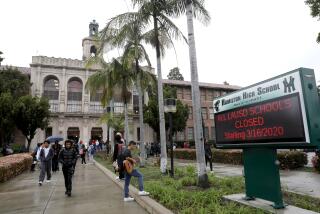School District’s Feud With Developer Imperils Deal : Santa Clarita: The agreement would establish a uniform building fee that comes to about $4,200 per unit in both the city and unincorporated areas.
A dispute between a developer and the Castaic Union School District threatens to unravel a laboriously negotiated agreement that would raise more than $50 million for new schools in the Santa Clarita Valley, officials said Thursday.
The agreement under negotiation would require developers to pay the school districts 58% more than the state-mandated fee of $1.58 per square foot, money that would go to relieve overcrowding in local schools.
After 18 months of talks, negotiators from Santa Clarita, local school districts, the building industry and Los Angeles County were nearing agreement last month on a fee of $2.50 per square foot, which would bring in half the projected cost of new school construction in the valley during the next 20 years.
The agreement would establish the same building fee in Santa Clarita as in the unincorporated sections of the surrounding valley.
The new fee would be about $4,200 per residential unit, compared to the present $6,000 per unit in the city and about $2,500 in the unincorporated areas.
It would also mean that Santa Clarita would not try to block future developments by using a court ruling that gives cities the power to deny permits to housing projects that do not provide money for sufficient public services, such as schools.
But the fragile compromise is jeopardized by financial arguments between the Castaic district and the Larwin Co. of Encino, and less serious difficulties encountered by the Sulphur Springs Union School District, officials said. Those problems “could bring this agreement to a screeching halt,” Santa Clarita City Manager George Caravalho said. “But we’re very hopeful that they can be worked out.”
At least 13,300 housing units would be subject to the new fee under the proposed agreement.
The problems first arose last month when Larwin and builder G.H. Palmer Associates of Brentwood refused to pay the higher fee for units that the county had already approved under the lower rate.
Larwin claimed an exemption for 690 units in its Hillcrest Park project in Castaic, and Palmer for 464 apartments in Canyon Country, officials said.
The exemptions would cost the Castaic district about $700,000 in lost fees, and Sulphur Springs would lose about $363,000.
Larwin President Michael Keston said in an interview Thursday that his company is unwilling to pay the additional 92 cents per square foot because the Hillcrest Park project was approved five years ago.
The company recently auctioned 20 homes in the project for $10,000 to $20,000 less than the original asking price because of the slump in the housing market.
But Keston said that at the request of county Supervisor Mike Antonovich, who represents the area, he will “provide more than my fair share” to the Castaic district by reducing the price of a school site owned by the company in the Hillcrest Park project.
Keston would not give exact figures, but a source involved in the negotiations said Larwin will discount the 10-acre parcel by $1.3 million from its appraised value of $4.9 million to $3.6 million.
“I think I’m a good citizen of this community who wants to give the children a place to be housed for school,” Keston said.
Jim Bauler, business manager for the Castaic district, said the land is worth less than the appraised value and that the district cannot afford to pay even the discounted price.
He said the district has scheduled a special meeting Aug. 22 to discuss the problem with Larwin, but warned that “we’re not going to let anyone wiggle out of the agreement.”
Sulphur Springs officials said they will not oppose the Palmer exemption.
But Supt. Robert Nolet said he is having difficulty obtaining a guarantee from Palmer that the builder will pay the higher fees in the future.
The company did not return repeated phone calls Thursday from The Times.
Without Palmer’s participation, “there’s nothing to prevent a developer five years from now from refusing to pay the fee and taking the issue to court,” Nolet said.
Rather than enter the agreement only to become embroiled in a legal battle over it, the district would prefer to extract funds from developers by using the 1988 decision by the state Court of Appeal, which held that local governments may reject construction projects that adversely affect schools, he said.
More to Read
Sign up for Essential California
The most important California stories and recommendations in your inbox every morning.
You may occasionally receive promotional content from the Los Angeles Times.










